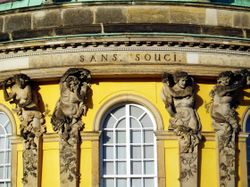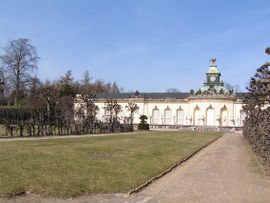سانسوسي
سانسوسي Sanssouci هو اسم القصر الصيفي السابق لفردريك الأكبر، ملك پروسيا، في پوتسدام، بالقرب من برلين. It is often counted among the German rivals of Versailles. While Sanssouci is in the more intimate Rococo style and is far smaller than its French Baroque counterpart, it too is notable for the numerous temples and follies in the park. The palace was designed by Georg Wenzeslaus von Knobelsdorff between 1745 and 1747 to fulfill King Frederick's need for a private residence where he could relax away from the pomp and ceremony of بلاط برلين. The palace's name emphasises this; it is a French phrase (sans souci), which translates as "without concerns", meaning "without worries" or "carefree", symbolising that the palace was a place for relaxation rather than a seat of power. The palace is little more than a large, single-story villa—more like the Château de Marly than Versailles. Containing just ten principal rooms, it was built on the brow of a terraced hill at the centre of the park. The influence of King Frederick's personal taste in the design and decoration of the palace was so great that its style is characterised as "Frederician Rococo", and his feelings for the palace were so strong that he conceived it as "a place that would die with him".[1] Because of a disagreement about the site of the palace in the park, Knobelsdorff was fired in 1746. Jan Bouman, a Dutch architect, finished the project.
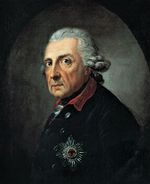
الجنة على الأرض
لا تقل حديقة سانسوسي وقصرها في مدينة بوتسدام جمالاً عن منتزه حديقة فورليتس ديساو والجدير بالذكر أن المعنى الفرنسي لتسمية سانسوسي هو "دون هم" وقد شُيّدت هذه الحديقة الضخمة وقصرها في عام 1745 من أجل أن يقضي الملك فريدريك الثاني، أو كما كان معروف تحت اسم فريدريك الكبير، وقت الصيف هناك بعيداً عن مشاغل الدولة والحكم ولكن قريباً من عاصمة حكمه برلين. وتعتبر المعالم الموزعة على خمسمائة هيكتار والتي تضم حدائق ومساحات خضراء وقصر سانسوسي وكنيسة ساكروفر وحديقة بابلسبيرغ وقصر غلينينر وجزيرة الطاووس في مدينة برلين المجاورة من أهم معالم المدينتين. ولكن قصر سانسوسي يعتبر أقدم جزء من كنوز التراث العالمي في برلين وبوتسدام على السواء. لقد ترك الكثير من مهندسي تصاميم الحدائق بصماتهم الفنية في إقليم بروسيا الألماني من خلال تصاميمهم المعمارية، وأشهرهم يعتبر "بيتر جوزيف لينيه" الذي صمم الكثير من الحدائق منذ عام 1818 ولمدة نصف قرن على التوالي.
عمارة سانسوسي
Interior of the palace
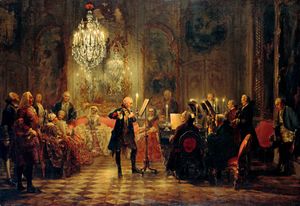
The terraced gardens
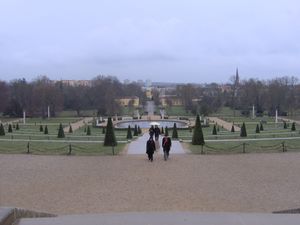
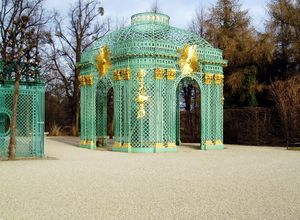
المتنزه
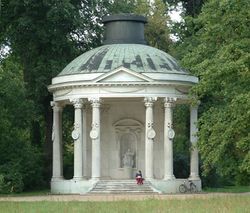

انظر أيضاً
Notes and references
- ^ Berliner Zeitung: Spröde Fassadengeschichten, 19 February 2003.
- This article was originally based on a translation of the corresponding German-language Wikipedia article retrieved on 12 March 2006. However, this version is much altered and expanded from that article.
وصلات خارجية
- ICOMOS evaluation of the World Heritage Site
- Images from Sanssouci
- Interactive Panorama: Sanssouci Garden
- 360° foto
- Official pamphlet of palaces and gardens in Berlin and Brandenburg
- Pages using gadget WikiMiniAtlas
- Articles with hatnote templates targeting a nonexistent page
- Coordinates on Wikidata
- Buildings and structures in Potsdam
- Castles in Brandenburg
- Landmarks in Germany
- Palaces in Brandenburg
- Parks in Germany
- پروسيا
- Royal residences in Brandenburg
- World Heritage Sites in Germany
- Rococo architecture of Germany
- Houses completed in 1747
- Prussian cultural sites

